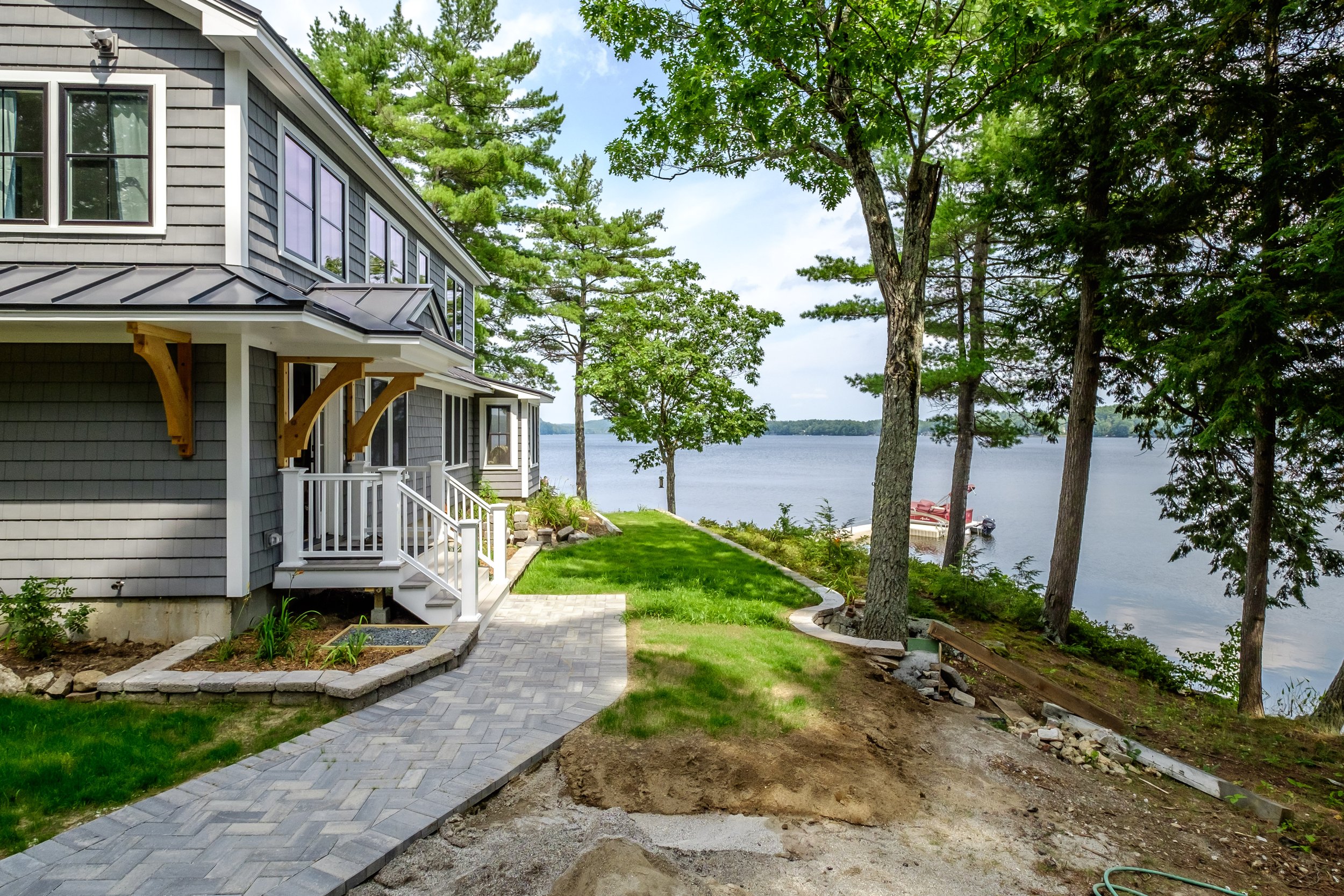Converting your seasonal cabin to a year-round home
This Androscoggin County camp was built in 1920 on a slight peninsula, with lake views on two sides. The owners wanted to take advantage of the 30% expansion, allowable to them under the shoreland zoning ordinance in Maine but also improve the efficiency of the structure to prevent frozen pipes and high winter heating costs. Mottram Architecture opened up the two sides facing the lake and added two bedrooms to the second floor, without expanding the home’s footprint or increasing runoff to the lake. The previously converted porch was turned into a well-insulated and air-sealed four-season sunroom taking advantage of the 180-degree view of the lake and increasing the usable square footage of the home year-round. PHOTO: MICHAEL ERIC BERUBE
From camp to comfort
By June Donenfeld
Interior of Mottram Architecture’s Androscoggin County 1920 camp conversion. PHOTO: MICHAEL ERIC BERUBE
BIRDSONG, PINEY BREEZES, a sparkling lake and a rustic cabin that lets you delight in it all. If you’re lucky enough to have a camp like this, as they’re called in Maine, it can be the perfect place to savor the beauty and serenity of nature. Once winter sets in, though, you’ll have to wait until spring to enjoy it again. But if you dream of being able to enjoy your camp in all seasons or want to make a dent, however small, in Maine’s severe housing shortage, here are some dos and don’ts to help you transform your camp into a year-round haven.
We contacted two of the Maine authors of the recently published Pretty Good House: A Guide to Creating Better Homes to get their thoughts. “Hire someone to help you figure out what you are allowed to do,” says Emily Mottram, a high-performance architect in Thomaston. “It can be complicated, and a good design professional can really maximize your project.”
Michael Maines, a high-performance, environmentally responsible designer in Palermo, concurs. “Talk to a design professional or design/build professional with experience doing this type of work,” he says. “Zoning, in particular, can be challenging to navigate.”
You can also consider working with a lumber and building supplier that offers in-house design services. This is what Cheryl Hutt did when she set out to weatherize and expand her small camp in Nobleboro. Though these services can be free of charge, this option is only available (understandably) to clients who get their supplies there, too.
Before anything else, make sure the changes you envision are legally feasible, as Maine has strict statewide shoreland zoning rules that will affect what you can do and where you can do it. Even if you are in a woodland area, you will still be subject to local zoning regulations, so contact your local town office before you get started.
Regardless of whether your camp is on a shore or in the woods, water and wastewater will be your two biggest issues, according to Maines. “Having a drilled well is much nicer than drawing your water from a lake and, depending where your property is located, probably required for a year-round home. And septic systems can be hard to locate on old sites, when the site is close to the water and there isn’t enough distance from neighbors’ wells and their own septic systems.”
Mottram seconds this. “When doing a camp conversion,” she says, “the worst surprise is usually that your septic or well needs to be replaced or moved, and often there is not a place for that to happen.”
And if a well isn’t an option? “A cistern might be possible,” says Maines, but as the current residential building codes don’t specifically mention this as an option, it’s best to check with your local town office to be sure.
Consider accessibility in and outside your home as well, especially when it comes to hardscaping features like paths and steps, and the steps up to and inside the house. While it may not be a concern now, Hutt recommends looking ahead: “Think of all the variables: your current stage in life, your future stages and who will be enjoying your new home in the short and long term. What modifications can you do today that will make your home more comfortable?”
To meet the needs of the three generations who use this historic 1908 home on the shores of Mooselookmeguntic Lake, Rangeley Building and Remodeling expanded it and changed the layout to create a functional, comfortable space that also includes many salvaged elements of the original camp. PHOTO: JEFF ROBERTS IMAGING
Once you’ve squared away these big-picture things, you can focus on the conversion itself. Jill Crosby, resident designer at design-build company Rangeley Building & Remodeling, says that the biggest mistake she’s seen camp owners make is “multiple attempts at jacking and leveling them to forgo putting in a permanent foundation. We can’t stress enough how important it is to get these places out of the dirt and onto a permanent foundation. This is the number-one way a camp will live on for many generations to enjoy.”
The next items on your conversion plan, like good air sealing, insulation and moisture control, will ensure your converted camp will be comfortable, healthful and durable. This is where building science comes in. Mottram warns not to skimp on ventilation and mechanical systems, like plumbing, electrical and heating or cooling. “We need to be sure we are providing the best durability for our structures, and that can’t be done without considering them,” she says.
This camp, on Long Pond in Rome, was renovated and added onto several times over the last 50 years. It had insulation and heating systems, but water still had to be shut off in cold weather, and mice had the run of the framing cavities. Michael Maines’ former company, MainesCraft, designed and built a small addition, weatherizing the structure with the help of The Breathable Home from 2018-2019. In this photo, carpenters Sarah Fagg and Jeremy Cloutier install white cedar shingles from Longfellow’s Shingle Mill in Windsor, over Benjamin Obdyke Slicker Classic rainscreen mesh. PHOTO: MICHAEL MAINES
Maines adds that owners should also “plan on having to do more work to the building envelope” than they might have thought “because seasonal camps are usually not detailed for good moisture control.”
When it comes to insulation, both Mottram and Maines avoid using petroleum products like foam insulation as much as possible for health and environmental reasons. “As a rule of thumb, we try not to use foam above grade and always put in heat pumps,” says Emily, “but as camps can be in remote areas, we do often have a wood stove for backup heat.” Her advice? “Use healthy materials to the best of your ability, even if it means you have to sacrifice somewhat on overall performance. A good air seal and healthy insulation will be good for the longevity of the structure and the occupants.”
Maines concurs, “If the building is not going to be fully occupied, I would not waste up-front carbon emissions on foam insulation or other materials with high levels of embodied carbon, and I would only use foam when other materials can’t do the job effectively (or cost-effectively).”
Your home’s layout, inside and out, also plays an important role in the functionality and enjoyment of your converted camp. For instance, Maines strongly advises, “If you have a great porch, don’t enclose it! People think that porches will be more useful as interior space, then they wonder why they don’t feel as connected to the site as they did when they had a nice screened porch.” Hutt’s conversion has the best of two worlds: a new, dual-use wrap-around porch: the lake-facing side will have screens that can be swapped out for glass in the winter and storm doors on either end, so she’ll be able to use it summer and winter alike.
To make the process go as smoothly as possible, consider using a project management app. Hutt says she uses hers “to capture ideas and decisions, quotes, spreadsheets, photos, website links, and communicate with my contractor, too. I’d be lost without it.” She also counsels patience. “Don’t rush in getting the construction complete—it’s difficult and expensive to have a ‘do-over.’ And expect unforeseen delays in all things, from contractor availability to deliveries that will affect other tasks.”
Also bear in mind that your wallet might take a bigger hit than you expect. In Mottram’s experience, “Renovation work is always more expensive than you anticipated, because every surface you touch needs to be repaired, and you often find rot, poor wiring or other surprises.” And because “camps were rarely built to precision standards,” she advises homeowners to “keep a healthy contingency for replacement or repair of their structure, because you can limit the scope to keep costs down, but you can’t control costs around things you uncover.”
Do your homework, choose your professionals wisely, be flexible, and you’ll be able to revel in your very own corner of paradise spring, summer, winter and fall.
The finished addition at Long Pond camp in Rome, Maine. PHOTO: MICHAEL MAINES
This article appeared in the Summer 2023 edition of Green & Healthy Maine. Subscribe today!
Find Maine experts that specialize in healthy, efficient homes in the Green Homes Business Directory.







